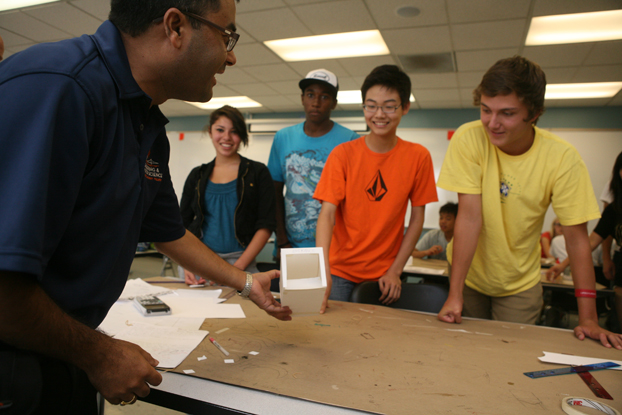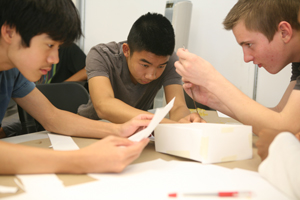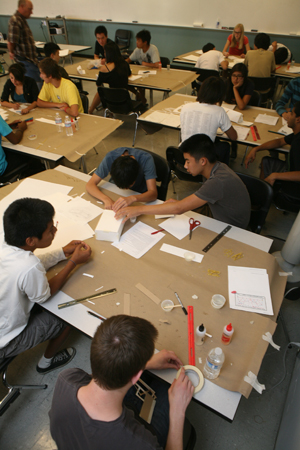 Caption: Binod Tiwari, assistant professor of civil and environmental engineering, tests the working condition of a mousetrap as the high school participants in this summer’s Engineering Innovation learn and watch. Photos by Greg AndersenDownload Photo
Caption: Binod Tiwari, assistant professor of civil and environmental engineering, tests the working condition of a mousetrap as the high school participants in this summer’s Engineering Innovation learn and watch. Photos by Greg AndersenDownload Photo
University STEM Initiative
A Bit of Glue and Engineering Concepts
Students Learn ‘What Is Engineering?’ in Summer Program
What is engineering? Just ask Binod Tiwari.
“Engineering is a discipline that uses the knowledge of science and math to develop things for the benefit of people,” said the assistant professor of civil and environmental engineering. “In other words, engineers are problem solvers.”
This is what Tiwari told 20 high school students from Orange County and neighboring communities during this summer’s “Engineering Innovation” program, made possible through a partnership between Cal State Fullerton and Johns Hopkins University in Baltimore.
The four-week program, which continues through July 29, gives young participants the skills to think and problem solve like an engineer — and exposes them to career opportunities in engineering disciplines.
“I tell my students that engineers have more responsibility to society than other disciplines because failure in any thing designed and made by engineers, including planes, buildings, bridges and nuclear power plants, can cause trouble to many people,” said Tiwari, who is teaching the program.
The introductory engineering program also is taught by Johns Hopkins teaching fellow Christopher Peoples, a Sunny Hills High School physics teacher.
“If an engineer makes a mistake, many people are affected at the same time. I also tell my students that engineering is art, engineering is finance, engineering is politics, engineering is design, and engineering is innovation.”
Engineering Innovation is part of the university’s effort to expose more students to education and careers in engineering, one of the science, technology, engineering and mathematics (STEM) fields. The program’s focus reflects CSUF’s heightened emphasis on increasing student interest in those fields.
“During the program, we expose students to the different disciplines to open their eyes to all the possibilities in the field,” said Tiwari.
Students spend five hours a day attending classroom lectures and performing hands-on activities where they put civil, electrical, electronic, mechanical and computer engineering concepts to the test.
For example, students learn how to build a better mousetrap by using paper, glue and rubber bands — and engineering concepts. Their success is measured not only by their ability to design a mousetrap that works, but one that their peers can do using their instructions, Tiwari said. Other learning activities include circuit design, calculating the distance between campus buildings to determine measurement and estimation, chemical experiments in the laboratory and making robots.
“They need to be clear about the design and give instructions others can follow, ultimately learning to think like an engineer,” Tiwari said.
 Caption: Issac Ngo of Oxford Academy, left, Brent Tom of Carlmont High School, center, and Kevin Scanlan of Tesoro High School use engineering concepts to build a mousetrap during this summer’s Engineering Innovation program.Download Photo
Caption: Issac Ngo of Oxford Academy, left, Brent Tom of Carlmont High School, center, and Kevin Scanlan of Tesoro High School use engineering concepts to build a mousetrap during this summer’s Engineering Innovation program.Download Photo
During the last two weeks of the program, students worked in groups to design and build a bridge using only spaghetti and glue for building materials. Friday (July 29), they will test their bridges for strength, the soundness of their engineering calculations and their bridge's compliance with engineering specifications. Participants also will analyze why some bridges fail.
The program features guest speakers like Juan Cepeda-Rizo of Jet Propulsion Laboratory who shared engineering concepts involved in designing rockets.
Students can earn three units of transferable college credit through Johns Hopkins University if they receive a final grade of A or B. In the last three years of the program, 90 percent of participants passed with a B or higher, Tiwari said.
“During this program, students not only learn how demanding college engineering courses are, but whether engineering is a good choice for them,” Tiwari said.
For Meredith Fleming, who will be a junior at Corona del Mar High School this fall, that’s exactly what happened: She has her sights set to become an engineer.
“If I can pass this course, then I know I can do any engineering class in college,” said the Newport Beach resident who is interested in aerospace and mechanical engineering.
On the other hand, Christine Rivas, a Santa Ana High School senior, had no idea what engineers do — before she took the course.
“I wanted to see what engineering is all about. Now I understand much more, and the program has shown me my weaknesses and strengths.”
Rivas also is participating in the Upward Bound program, a federally funded TRIO Program, designed to assist underrepresented high school students with preparation for postsecondary education. Upward Bound sponsored her attendance in the engineering program.
While Rivas enjoys math and science, she’s unsure whether she will pursue engineering. But one thing is for sure, she plans to go to college.
“After taking this course, when I go to college — on the first day — I won’t feel so lost. I’ll know what to expect,” she said.
For more information about the program or next year’s sessions, visit the Engineering Innovation website.
For more information about the university’s engineering programs, go to the College of Engineering and Computer Science website.
July 26, 2011

